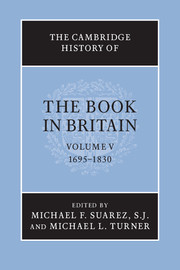Book contents
- Frontmatter
- Introduction
- PART I THE QUANTITY AND NATURE OF PRINTED MATTER
- PART II ECONOMIC, LEGAL AND CULTURAL CONTEXTS
- PART III THE TECHNOLOGIES AND AESTHETICS OF BOOK PRODUCTION
- PART IV THE BOOK TRADE AND ITS MARKETS
- V BOOKS AND THEIR READERS
- I RELIGIOUS BOOKS
- II LITERATURE AND THE CULTURE OF LETTERS
- III SPECIALIST BOOKS AND MARKETS
- 38 Collecting and the antiquarian book trade
- 39 The Stationers’ Company and the almanack trade
- 40 Children’s books and school-books
- 41 Music
- 42 Maps, charts and atlases in Britain, 1690–1830
- 43 Enlarging the prospects of happiness: travel reading and travel writing
- 44 Law books
- 45 Philosophical books
- 46 Scientific and medical books, 1695–1780
- 47 Scientific and medical books, 1780–1830
- 48 ‘Radical publishing’
- 49 Mining the archive: a guide to present and future book-historical research resources
- Abbreviations used in bibliography
- Bibliography
- Index
- Frontispiece
- Plate section
- References
46 - Scientific and medical books, 1695–1780
from III - SPECIALIST BOOKS AND MARKETS
Published online by Cambridge University Press: 28 September 2010
- Frontmatter
- Introduction
- PART I THE QUANTITY AND NATURE OF PRINTED MATTER
- PART II ECONOMIC, LEGAL AND CULTURAL CONTEXTS
- PART III THE TECHNOLOGIES AND AESTHETICS OF BOOK PRODUCTION
- PART IV THE BOOK TRADE AND ITS MARKETS
- V BOOKS AND THEIR READERS
- I RELIGIOUS BOOKS
- II LITERATURE AND THE CULTURE OF LETTERS
- III SPECIALIST BOOKS AND MARKETS
- 38 Collecting and the antiquarian book trade
- 39 The Stationers’ Company and the almanack trade
- 40 Children’s books and school-books
- 41 Music
- 42 Maps, charts and atlases in Britain, 1690–1830
- 43 Enlarging the prospects of happiness: travel reading and travel writing
- 44 Law books
- 45 Philosophical books
- 46 Scientific and medical books, 1695–1780
- 47 Scientific and medical books, 1780–1830
- 48 ‘Radical publishing’
- 49 Mining the archive: a guide to present and future book-historical research resources
- Abbreviations used in bibliography
- Bibliography
- Index
- Frontispiece
- Plate section
- References
Summary
Eighteenth-century Britain witnessed both the rise of a consumer culture and the emergence among the public of an intense curiosity about the natural world and humankind’s place in it. The intersection of these forces produced a flood of scientific and medical literature, including journals, pamphlets, broadsides and books. Recent scholarship has emphasized that the early modern scientific and medical book was the product of a messy, often contentious, process of negotiation among various parties – author, bookseller, printer, scientific or medical community, etc. – all of whom contributed in some way to the creation of an item that was at once a physical object, a text, a set of ideas (which might or might not be innovative, or even ‘true’), the basis of an author’s credibility and a bookseller’s commodity. Consumers bought books in order to gain access to one or more of these elements. Once purchased, a book could become something else to its owner, transforming (perhaps) into a scholar’s obsession, a child’s scrapbook, a lady’s companion or just one of hundreds of elegantly bound tomes adorning the walls of a gentleman’s library.
From among these myriad meanings we can tease out some generalizations about scientific and medical books. First, eighteenth-century scientific books – including texts on the physical and natural sciences, as well as mathematics and applied mathematics – were produced not just for practitioners, but also for gentlemen amateurs, curious ladies and middle-class schoolboys. Similarly, medical texts – including works in physiology, anatomy, pharmacy, and the various medical and surgical practices – made these disciplines more accessible and comprehensible to potential patients and at-home practitioners, as well as to the expanding community of medical practitioners. Within the bookselling community, certain firms came to be associated with both types of literature: thus, for example, scientific publishing was a speciality of John Nourse, William Innys, Andrew Millar, and the Longman and Rivington families, while John Murray of London and Charles Elliot of Edinburgh were known for producing medical books.
- Type
- Chapter
- Information
- The Cambridge History of the Book in Britain , pp. 818 - 826Publisher: Cambridge University PressPrint publication year: 2009



